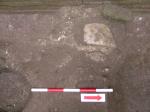Interpretation
-
- Much reduced and destroyed remains of a structure (tomb? altar? something to do with the raising of the height of the church?). Fill 3171 and 3161 contain many of the same components, but neither are bonded as 3175.
-
- Megan McNamee
- 21-6-2010
Stratigraphic Relationships
- No Linked Records
Site Photo
Description
- compostion
- trowel, pick
- N-S: 0.48 m; E-W: 0.43 m
- clay and pebbles; the context is largely comprised of large components
- earth: gray-brown, lighter due to significant amounts of decomposing tufa and a light, straw-colored tufarn
- loosely bonded; more compact at lowest limits
- poor (see observations)
- artifical
- small white bits (chalk or lime? may be a fine white crumbly mortar), large stones (part of the rubble)
- earth with flecks of charcoal
- small fragments of pottery, large fragments of worked tufa and marble (slabs), two mosaic tesserae, very small fragments of brick, tawny straw colored mortar
- Rubbley deposit filling SU 3176. Located on west side of chapel. Overflows the limits of its cut. Loosely bonded to wall.
- Exposed since 2007. Traces of the same, distinct pale mortar visible south of the context on the west wall. The mortar around the column base is not unlike the mortar of this fill. The original limits of this context were much reduced by the shallow trench cut N-S along western wall and the cut for the crucible. The contents are also very like those of the built tombs in the center of the chapel.
- good
Ceramic Inventory
| Total fragments | |
|---|---|
| 2 |
Basic Information
- Loosely bonded material filling SU 3176
Record Details
- Megan McNamee
- 21-6-2010
